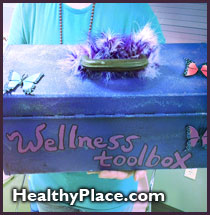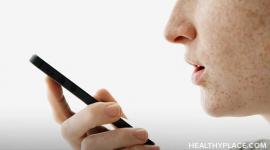Developing a Wellness Toolbox
 The first step in developing your own Wellness Recovery Action Plan [WRAP] is to develop a Wellness Toolbox. This is a listing of things you have done in the past, or could do, to help yourself stay well, and things you could do to help yourself feel better when you are not doing well. You will use these "tools" to develop your own WRAP.
The first step in developing your own Wellness Recovery Action Plan [WRAP] is to develop a Wellness Toolbox. This is a listing of things you have done in the past, or could do, to help yourself stay well, and things you could do to help yourself feel better when you are not doing well. You will use these "tools" to develop your own WRAP.
Insert several sheets of paper in the front of your binder. List on these sheets the tools, strategies and skills you need to use on a daily basis to keep yourself well, along with those you use frequently or occasionally to help yourself feel better and to relieve troubling symptoms. Include things that you have done in the past, things that you have heard of and thought you might like to try, and things that have been recommended to you by health care providers and other supporters. You can get ideas on other tools from self-help books, including those by Mary Ellen Copeland:
- The Depression Workbook: A Guide to Living With Depression and Manic Depression,
- Living Without Depression and Manic Depression: A Guide to Maintaining Mood Stability,
- The Worry Control Book,
- Winning Against Relapse,
- Healing the Trauma of Abuse,
- The Loneliness Workbook.
You can get other ideas from the audio- tapes
The following list includes the tools that are most commonly used to stay well and help relieve symptoms:
- Talk to a friend - many people find this to be really helpful
- Talk to a health care professional
- Peer counseling or exchange listening
- Focusing exercises
- Relaxation and stress reduction exercises
- Guided imagery
- Journaling - writing in a notebook
- Creative affirming activities
- Exercise
- Diet considerations
- Light through your eyes
- Extra rest
- Take time off from home or work responsibilities
- Hot packs or cold packs
- Take medications, vitamins, minerals, herbal supplements
- Attend a support group
- See your counselor
- Do something "normal" like washing your hair, shaving or going to work
- Get a medication check
- Get a second opinion
- Call a warm or hot line
- Surround yourself with people who are positive, affirming and loving
- Wear something that makes you feel good
- Look through old pictures, scrapbooks and photo albums
- Make a list of your accomplishments
- Spend ten minutes writing down everything good you can think of about yourself
- Do something that makes you laugh
- Do something special for someone else
- Get some little things done
- Repeat positive affirmations
- Focus on and appreciate what is happening right now
- Take a warm bath
- Listen to music, make music or sing
Your list of tools could also include things you want to avoid like:
- alcohol, sugar and caffeine
- going to bars
- getting overtired
- certain people
Refer to these lists as you develop your Wellness Recovery Action Plan. Keep it in the front of your binder so you can use it whenever you feel you need to revise all or parts of your plan.
Note: I'm also using Advocacy as a wellness tool.
next: A Depression Recovery Story
~ back to Mental Health Recovery homepage
~ depression library articles
~ all articles on depression
APA Reference
Staff, H.
(2008, December 29). Developing a Wellness Toolbox, HealthyPlace. Retrieved
on 2025, November 29 from https://www.healthyplace.com/depression/articles/developing-a-wellness-toolbox



